(
go to part 5)

Hurricane Katrina caught Dara, toddler Levi, baby Asher, and me in Albuquerque, where we had gone to visit my parents and to attend the Bubonicon science fiction convention. The entire New Orleans metro area was cordoned off to residents after the east bank levees broke and eighty percent of the city flooded.

For weeks, we were unable to ascertain the status of our house. Being on the West Bank, our home hadn’t been within the primary flood zone, but according to reports, there had been localized flooding in Algiers, and the possibility certainly existed that our roof had blown off. At one of the four public computers in our hotel near the Albuquerque airport, I scoured the
New Orleans Times Picayune message boards several times each day, searching for posts from the few people in Algiers who had ridden out the storm or the first responders who had gathered at our neighborhood fire stations and a local religious college. I learned that the businesses closest to our house, the grocery store and hardware store on General Myers Avenue, about a half-mile away from our block, had been looted. That sounded ominous. And our local mall had been set on fire.

our neighborhood shopping mall set afire by looters
Our most pressing concern was for the safety of our cats. Expecting to only be gone four days, we had left them in the care of our handyman, Mr. Martin. He had set out bowls of food and water for them and filled our bathtubs with water before evacuating. Dara was frantic. Apart from her actual babies, those were her babies. I read on the message boards that animal rescue volunteers had begun arriving in New Orleans, somehow getting through the cordon. I left message after message, hoping someone on the ground there would read them, begging anyone to go to our address, break a window, and put out more food and water for our cats trapped inside.
One of our neighbors, a police officer, did just that. A week or two later, Mr. Martin was able to sneak back to his home in Lower Coast Algiers. He went to our house and caught each of the cats, then took them to Thibodeaux, where another friend of ours was running a temporary, emergency animal shelter. All eight of our cats survived, but four of them would die within the next eighteen months, having been weakened by their ordeal.
I was also worried about my laptops, or rather, my writing files. I had backed up all of my files on multiple laptops, but most of those laptops were stuck in our house in Algiers. The others I kept in my office at the State Office Building downtown, on the fourth floor. But news reports mentioned that my office building had suffered severe damage, and I kept my personal backup laptops in a credenza next to the window. If I had been truly unlucky, my writing computers at both locations could have been destroyed by pounding rains.
From Surfside, Florida, where my family and I were staying in a friend’s uncle’s temporarily unoccupied condo, I put out a call for any of my friends or professional associates who might have electronic copies of my stories or novels to email them to me. Many did. Some went above and beyond. Science fiction writer Steve Stirling in New Mexico shipped me a Hewlett Packard Pavilion laptop which he was no longer using. Bradley Denton in Austin, Texas made me a copy of my beloved word processor, WordPerfect for DOS version 5.1, and mailed it to me so I could install it on Steve’s laptop.
I started taking Asher in his stroller to the nearest coffee shop and working on the laptop, writing chapters of a new book I intended to write, explaining how New Orleans had become so socially and economically vulnerable to a disaster like Katrina. I intended to call the book
The Janus-Faced City–New Orleans Since 1980: Looking Backward, Stumbling Forward, and Second-Lining Through Puddles of Blood. It would cover everything from the decay of the public schools to the mid-1990s murder spree to my campaign against holiday gunfire. I wrote quickly, fueled by stress and caffeine. A comedy this wasn’t.

Louisiana Superdome after Katrina
I flew back to New Orleans on October 15th, about six weeks after the storm had blown through. I left Dara and the kids in Surfside, intending to fly back after I had scouted out the situation, and then drive them home in the van we’d purchased in Miami. I discovered Dara’s car still parked in the airport lot, not flooded as I’d feared, but covered with a thick layer of dust and grime (the Army Corps of Engineers had dumped a mountain of storm debris in a lot right behind the parking lot). To the credit of Ford Motor Company, the Mercury Grand Marquis started right up; pretty Grand, all right. I paid for six weeks’ worth of parking. Driving home, I passed the waterlogged ruins of parts of Kenner. Twenty minutes later, on the Pontchartrain Expressway, I drove past the badly damaged Superdome, home to so much well-publicized suffering, the tatters of its roof hanging from its sloping sides like pieces of peeled orange rind.
Our house was relatively okay. We would have to replace the roof, all of our fencing, our gutters, and cut down most of our trees, but in the larger scheme of things, this was a mere flesh wound. The oddest evidence of the storm’s fury was our outdoor ceiling fan, still hanging from the ceiling of our carport but denuded of its blades. I discovered chunks of those particle board blades all over our back yard. The winds had spun the fan so fast that centrifugal force had torn the blades apart.
Mr. Martin, more than just a handyman, also a dear family friend, had already removed our refrigerator and carted it away. Considering that it had been full of rotted food and who knows what kind of microbial and insect life, that was a real blessing. (And unlike our then-Congressman William Jefferson, I hadn’t stored ninety grand in ill-gotten cash in my freezer.)
I walked upstairs, not knowing what I’d find. Despite the damage to the roof, no rain had entered the rooms of the house. The laptops were all where I’d left them six weeks earlier.
I found myself experiencing surprisingly mixed emotions. I was overjoyed, of course, that my writing files and my favorite computers had come through intact. But I realized some part of me had been expecting that Katrina would had freed me from the burden of my oversized accumulation of mostly nonfunctional old tech. And that anticipation had promulgated, not grief, but relief. Honestly, if half our roof had come off and our back yard had become a lake but the laptop room had survived unscathed, I would have tossed most of the laptops out the second story window into the flood water and settled with the insurance company for whatever they would’ve given me.
We went through eighteen lean months, post-Katrina. Dara lost her job, and our household income was slashed by forty percent. She had been working as a grants writer for a supportive residence housing AIDS sufferers, but after the storm, with so many local medical services gone, the residence relocated to northern Alabama. We were blessed with a third son, Judah, a little more than a year after we’d returned home. For a while, I continued working my job with the State Nutrition Section, helping to put back the pieces of the Louisiana Commodity Supplemental Food Program, which had lost eighty percent of its stored commodity foods and food delivery trucks when its warehouses near Lake Pontchartrain had been obliterated by wind and flooding. Upon Judah’s arrival, we found ourselves newly eligible for the low-income food program which I’d been managing for fifteen years.
My income from the State of Louisiana wasn’t going to cut it. And I wasn’t going to be selling any more books anytime soon, either; my agent, Dan Hooker, passed away from cancer the Thanksgiving following Katrina. I missed my window of opportunity with the nonfiction New Orleans book.

I tried selling Saturn cars and trucks for a few months; I picked Saturn because I didn’t want to do high pressure sales. While waiting for customers to arrive at the dealership, I sat outside the front entrance with my Poqet PC and worked on my latest novel,
The Bad Luck Spirits’ Social Aid and Pleasure Club. It was a fantasy-horror version of the Katrina disaster, sort of a fictionalized take on my prior, non-fiction project,
The Janus-Faced City. I slowly got better at selling cars and made a reasonable number of deals, for a beginner, but I couldn’t see the light at the end of the tunnel arriving fast enough, so I ended up returning to my job with the State of Louisiana.
I finally grabbed hold of my lifeline when I signed on with FEMA, the Federal Emergency Management Agency. I would be a two-year temporary employee, working acquisitions and program management, with my main assignment being to develop and oversee a quality management program for the housing trailer distribution program; FEMA was in the midst of setting up travel trailers and prefabricated housing for over ninety thousand people, installing them on the driveways of residents’ flooded homes or in trailer parks.

Of course, going to work for FEMA, and
shlepping around New Orleans wearing a FEMA jacket in the years following Katrina, had its down side. FEMA was widely loathed for what many residents saw as its tardy response during the days after Katrina’s landfall, and the agency hadn’t exactly buffed up its reputation with its distribution of temporary housing trailers, later found to be contaminated with potentially carcinogenic levels of formaldehyde. Joining FEMA at the beginning of 2007 was sort of like joining the Nazi Party in Germany. In 1946. But they were paying me almost twice what I’d been earning at the Nutrition Section. And they were sending me to classes to learn formal program management, which I hoped could lead to permanent employment down the line.
A year before the end of my temporary employment, I began job hunting with a vengeance, hoping that my new program management certifications would give me a leg up. At the beginning of 2009, after I’d submitted more than 150 sets of KSAs (Knowledge, Skills, and Aptitude essays) to various job announcements, I finally found an employer who wanted me. But the new job was located in Washington, DC. And I was warned that the security clearance process could take six months or longer. Maybe much longer.
My life and the lives of my family became dominated by an unnerving race. Which would happen sooner–the approval of my security clearance, or the end of my employment with FEMA? I had already stayed on with FEMA several months longer than the two years they’d promised me. Work at the Transitional Recovery Office in New Orleans began winding down. Each week, more sections of the office were abolished, and more people were let go. No one knew for certain when the ax would fall on their neck.
Meanwhile, I knew I had to get rid of some laptops. A lot of laptops. Housing was much, much more expensive in the Greater Washington, DC area than it was in New Orleans. So whatever we ended up moving into would almost assuredly be considerably smaller than our house in Algiers. We all would have to downsize. Me, most of all.
At the neighborhood coffee house where I did all my writing, I knew a guy who ran an eBay business selling various types of collectibles. Months ago, I’d mentioned my collection of vintage laptops to him, and he’d told me that whenever I decided to unload them, I should keep him in mind. He was excited when I told him I needed to sell about a hundred and fifty of them. We agreed that I would provide him with a detailed catalog of the whole lot, describing features, condition, working status, and model numbers, and that we would split the proceeds seventy-thirty. Knowing I had no time to market and ship the machines myself, I figured it was well worth it to let him keep thirty percent net of whatever he sold the units for.
We drew up a contract. I began the arduous task of sorting through the laptops, testing each one and writing up descriptions in a database. Part of my job was to decide what I wanted to keep. I set myself some rules to live by. I decided to keep all the palmtops, the Poqet PCs included, since they were small and useful for writing (and I felt a strong emotional attachment to them). For similar reasons, I would retain the newer and most complete subnotebook computers, the ones that I had extra batteries and external floppy drives for. However, I would only keep a machine if, when I looked at it, I experienced that queer pitter-patter in my heart that meant total infatuation. I also decided that any unit that wasn’t fully functional, or that I couldn’t make fully functional with a minimal amount of effort and expense, I would get rid of.
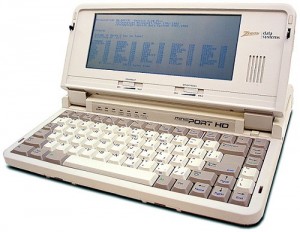
This last parameter led to a good bit of disappointment and heartbreak. There were machines that I simply loved, that I desperately wanted to keep, but that I discovered upon testing (for most of them, the first time I had tried turning them on in years) were DOA. Dead on Arrival. I had managed to accumulate five very rare Zenith MinisPort laptops, including the original ZL-1, the upgraded ZL-2 with more memory, and the ultimate version, the ZL-0001-H, with a 20 megabyte hard drive. All featured Zenith’s unique two-inch floppy drive, a component not used in any other laptop before or since. I had manuals and extra batteries and external drives for them. I also had a full box of the almost impossible-to-find Fujitsu 2″ floppies, originally made for digital cameras. Two of the MinisPorts would not power on. One of them would boot, but then immediately shut itself down. One booted just fine, but its screen’s backlighting had stopped working, so the screen was unreadable unless you shined a very powerful light directly on it.
Most heartbreaking of all was the MinisPort that looked like it was mint from the factory. Its plastic body had remained pure cream white, rather than having turned a dingy yellow, as so many other units of similar color and vintage had. Its keys were all firm and went clickety-click. Its screen was flawless. Its one issue? It was missing the female connector plug for the AC adaptor to hook up with. There was no way to give it any juice.
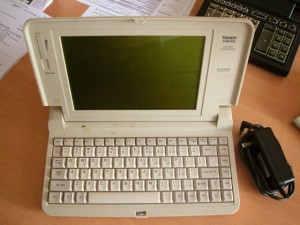
And then there were the Tandy 1100FDs and the Panasonic Business Partner CF-150B. Also heartbreakers. These were my first loves–the Tandy I had aggressively flirted with for months in 1989 and 1990, and the Panasonic I had actually married; it was the model I had brought with me to New Orleans, the laptop I had composed my first novel with at Borsodi’s Coffeehouse. Over the years since that original Panasonic had bit the silicon, I had collected four Tandy 1100 units, including three 1100FDs with the single floppy drive and one 1100HD with a 20 megabyte hard drive, and I had managed to find just one more Panasonic CF-150B Business Partner. One of the Tandys still rested in its original box, with all the original manuals and pamphlets. Four of the five booted flawlessly from ROM (the only one that wouldn’t was the Tandy 1100HD, which had fatal disk errors on its hard drive). But each and every one had a faulty 3.5″ floppy disk drive. With each, the floppy drive would spin up, but it wouldn’t read diskettes or write to them. The same dismal fate had befallen my original Panasonic CF-150B. A single Matsushita factory in Japan had manufactured all of these machines. Obviously, they had built or procured a really sucky batch of 3.5″ floppy drives, because those drives were the Achilles heels of these otherwise sweet and beguiling machines. (I still have a soft spot in my heart for lime green luminescent screens, and I always will.)
After about five weeks of intermittent labor, I completed the painful, yet fascinating task of culling my herd. I’d renewed my connection with my collection, just as I was about to liquidate almost two-thirds of it. I boxed up the machines without carrying cases, then externally labeled every single one of the 149 units I had decided I could part with. And just in the nick of time–we had acquired a buyer for our house (a real blessing in the terrible real estate market of 2009), which meant, ready or not, we were moving very soon.
I told my friend from the neighborhood coffee house that he needed to come over and take a look at what I had set aside for him. The moving truck would be arriving in a week; all of our things would be placed into a storage unit in Northern Virginia. My friend had mentioned he had a neighbor with a truck who would help him move the computers to his condo, where he’d be storing them until he found a buyer. I told him I’d be happy to help move the laptops over to his place with my minivan.
We made arrangements for the two of them to come the next night. They didn’t show. I called my friend, who complained he had a cold. I commiserated but said the moving truck was on its way and so we had to get this thing done. We arranged to meet again the next night. Again I came home early from work. Again he didn’t show.
He had gotten cold feet. The son of a bitch had decided to welsh on our deal. We had signed a contract, true. But the only way that contract would mean anything would be if I were to take him to small claims court–which, given my time constraints, was completely out of the question.
I panicked. Dara and I were in the middle of boxing up all the hundreds of things we’d decided to keep and take with us to Virginia. I didn’t have time to professionally box up a hundred and forty-nine laptops I had no intention of hanging onto, nor did I want to pay to move them across the country and then store them. The additional expense was a moot point; the movers wouldn’t touch them unless they were sealed up in moving boxes, not even the ones in carrying cases. And currently the units were piled up all over my office, blocking furniture and dozens of items that the movers would have to pick up. I had to get rid of those 149 laptops, one way or another. Quickly.
I called local computer repair shops, thinking one might be willing to buy the laptops as a source of spare parts. No go. I search the Internet for nearby eBay consignment shops where I could drop them off. Couldn’t find any; the closest ones seemed to be in Shreveport or Memphis. I put
an ad for the computers on Craig’s List. No callers. I looked for people who ran businesses similar to that owned by my ex-friend the son of a bitch, either specializing in collectibles, vintage electronics, or computers. The clock kept ticking down.
I finally found a guy who lived in Mandeville, about fifty minutes north of me, on the North Shore of Lake Pontchartrain, who said he sold computers on eBay and who was willing to take a look at what I had. I told him if he were interested, we would split the net proceeds forty-sixty (if he’d balked, I would have offered him a fifty-fifty split; another moot point, as things turned out). He drove over with his pickup truck. He told me he’d take the laptops. I didn’t do a contract this time; what good had a signed contract done me the last time? It was a handshake deal. I gave him a print-out of the database describing the units, we agreed that he would initially try to sell the machines as a lot on eBay for a price of $3,999, and I helped him load all the laptops into the back of his pickup truck, the afternoon before the morning the moving men were scheduled to arrive.
My seller called me a few hours later to apologize that one of the laptops had fallen off the bed of the truck and gotten smashed on the road. All I could say was, c’est la vie. (Or I could start singing, “A hundred and forty-nine laptops on the back of a truck, a hundred and forty-nine laptops, one fell, what the hell, a hundred and forty-eight laptops. . .”)
So then it was off to Northern Virginia, the family and animals split between two minivans, the moving truck somewhere behind us. We took three days to make the drive, then moved ourselves and three cats into a Best Western Motel. We spent the next few weeks making sure everything got unloaded properly from the moving truck into the storage unit and waiting for my security clearance to finally finish worming its way through the bureaucracy so I could start working.
My seller was pretty good at keeping in touch, at first. He took photos of a few of the 148 surviving laptops and posted them on eBay, offering to sell them all as a lot, shipping costs to be determined at the time of sale. I was able to follow the action online. Or rather, the lack of action.
After a few weeks, we agreed we would drop our asking price by $500, to $3,499, and add a “Make Your Best Offer” option. Still no signs of life from would-be buyers. I told him to drop the price another $500 and asked him to post some more photos (he’d only posted four or five pictures, and they weren’t of the most interesting machines).
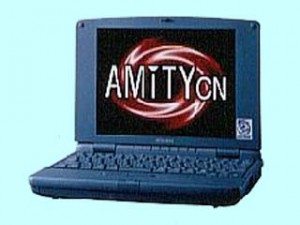
Meanwhile, I finally started my new job. I began taking the commuter train into work and doing my fiction writing on the train, using one of the subnotebooks I’d hung onto, a Mitsubishi Amity CN that I could still buy cheap rechargeable batteries for. We found a house to move into, a smallish split-level on a beautiful one-acre wooded lot. The kids started attending their new school. We signed them up for Tae Kwan Do lessons. A frog moved into our oak barrel pond. The boys named him Jumpy Junior (there had been a former Jumpy in New Orleans). Life moved on, as it tends to do.
I stopped hearing from my would-be seller in Mandeville, Louisiana, almost nine hundred miles away. The eBay listing came down. I tried emailing him a few times more but didn’t hear back. After a while, I chalked it up to one of life’s losses. I figured he’d either donated the laptops to a local school so the kids could dissect them, which would be all right, virtuous, in fact; or he’d taken them to the nearest landfill, which wasn’t all right at all.
All those toxic rare earth metals, all those lead acid and nickel-cadmium and lithium-ion batteries leaking their poisons into the South Louisiana dirt. . . All those wonderful machines, once the pinnacle of technology, once the fount of dreams and innovation and productivity, now mixed in with old coffee grinds and classified ads and soiled plastic diapers. . .
It pained me to think about it. So I stopped thinking about those 148 laptops and the money I’d spent on them. Mostly. I couldn’t get too angry at my would-be seller. Unlike the jerk from the coffee house, at least he’d tried. The possibility still existed that he’d done something worthwhile with my machines. Maybe it was better that I’d never know for sure.
* * * *
Postscript
I’m fully recovered from my vintage laptop hunter-gatherer obsession, my collectivitis. I sometimes test myself by getting back on eBay and searching for some of my old favorites. The real old-timers, the Zenith MinisPorts and SupersPorts, the NEC Ultralites, the Compaq LTEs, the one-time wonder machines made by vanished companies like AST and GRiD and Zeos, they rarely show up anymore. When they do show up, I find myself wondering if the unit on bid hadn’t been mine, once.
The only time I find myself experiencing a vestige of the old tingle, the old excitement, is when I’m searching for stuff my kids want. When I’m bidding on Thomas the Tank Engine wooden trains or Justice League action figures, a musty shade of the old, crazy Andy Fox, circa 2000, may briefly possess my fingertips on the keyboard. But only briefly, and with negligible damage to my bank account. I control my bidding now; it doesn’t control me.
My life is so much more full now than it was in 2000. Filled with kids and family and work. So I don’t suffer from a hungry, yawning chasm inside that I get frantic to fill with boxloads of stuff. And I thank God for that.
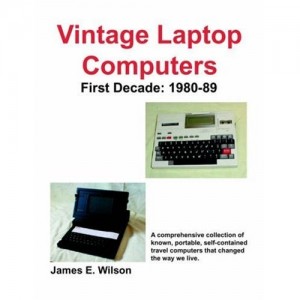
Someone did end up publishing a book on collecting vintage laptops. Fellow collector James E. Wilson published
Vintage Laptop Computers: First Decade: 1980-89 in 2006. So I wasn’t alone in my obsession. It’s available on Amazon and, of course, on eBay.
Oh, maybe one of these days I’ll find a complete and fully functional Tandy 1100FD or Panasonic CF-150B Business Partner, just so I can show it to my boys and tell them, this was your father’s very first laptop, the machine I wrote my earliest novels and stories on.
As for my one-time collection of 148 vintage laptops, now most likely moldering in a South Louisiana landfill? Maybe archaeologists of the future will dig them up hundreds of years from now. Maybe the loamy Louisiana soil will have been kind to them, and, like the righteous dead in some distant End of Days, they will emerge from the darkness restored to their rightful bodies, their batteries refreshed, their screens glowing or reflecting a bright lime green, those damn 3.5″ floppy drives finally working the way they should.
___________________________________________________________________________
Like this:
Like Loading...











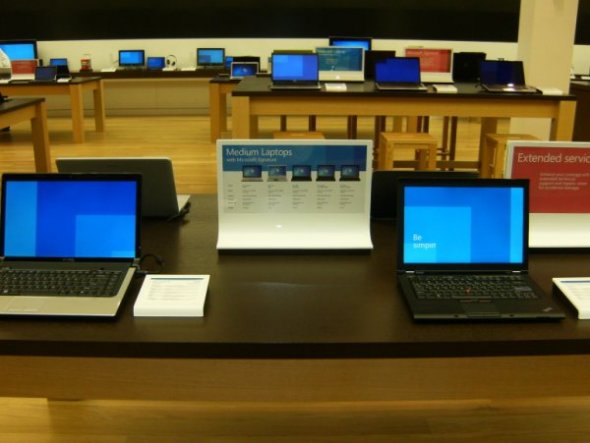
Enjoyed this series tremendously.
Thanks
Chris, I’m so glad you liked it! I hope you can benefit from my experience and avoid the perils of “acquisition-itus” and “eBay fever.” I still love me some old-time laptops, though.
Andrew, don’t worry, even if I did have any tendency to collecting, because I am currently living in a developing country they have cut off my paypal! And forget post or Fedex, if they don’t steal it, dealing with customs is a nightmare. Amazon is also not keen on me buying ebooks either, I guess for copyright reasons. They know from your IP address where you are. So I stuck in the 1990’s shopping style.
I also don’t have any fond memories of my early laptops either, because I was always in corporate land, I have had the most boring ones (usually thinkpads). I got my first laptop in 1990, a Compaq, don’t remember what the name was. I was working in another companies office’s, so the IT guys set it up so I could dial into the mainframe for email access. A friend worked out that all the IBM mainframes were somehow connected, and you could actually email people in other companies, which seemed amazing at the time.
Keep at your writing, your subject matters (vampires) is not my taste, but I like your writing style.
Chris, thanks so much for the additional message and for getting in touch. What an amazing world we live in, where people can become friendly acquaintances with each other and be on opposite sides of the world! By the way, my third book, The Good Humor Man, isn’t a vampire book; it’s science fiction, an homage to Ray Bradbury’s Fahrenheit 451. So if you like that sort of thing, you might want to check it out. Keep checking back at the website for more articles, by the way. I try to post at least three times a week.
Great story. I almost headed down your path, collecting old, weird UNIX desktops. I realized I had a problem at about 30 machines.
My first laptop was a MinisPORT, purchased on clearance with one box of floppies. I’d love to have one again.
Ah, the MinisPort. At one point, I had five of them. None of them worked. One was in absolutely gorgeous condition… but was missing its female plug for the power converter. When I moved, I vowed to myself to only keep those machines which were in good working order. How I wished at least one of them could have been a MinisPort. Thanks for writing!
Thanks immensely for taking the time to write these articles Andrew, they make for strangely addictive reading. As an admirer (and still active owner) of the PSION palmtops and their wonderful hardware and OS integration I have an immediate lust for a Poqet PC which I fear can only be tempered by acquiring one!
I am surprised you never mentioned the little Toshiba Libretto series, I would have thought they were right up your street.
Steve, I’m really happy you enjoyed the articles — “strangely addictive reading” about a strangely addictive hobby! I never ended up buying any of the Psions, although they interested me, given their larger-than-typical-for-a-palmtop keyboards (I still might spring for a Psion 5 at some point, when I’m feeling goofy and spendy). I admired the Toshiba Librettos, but when I was in the thick of my collecting period (1999-2002), they were still on the newish side and thus a bit too expensive for me to “invest” in. The one I REALLY wanted was the Libretto-sized IBM 486 unit, the IBM PC 110 sold only in Japan, but I could never find one of those on eBay even remotely “reasonably” priced. Even though I never ended up buying any Librettos, I did buy several Libretto “knock-offs” — the Mitsubishi Amity series, which, being made by an “off brand,” were cheaper to acquire. I still use one of these as my primary fiction-writing computer (sticking with good ol’ WordPerfect 5.1 for DOS!) that I take with me on my daily train commute to work.
Thanks for writing! I hope you’ll visit again.
The beginning of these articles actually reminded me a lot of going into a Boots chain which had a small business/electronics dept and playing with their display PSIONs, although they were way out of my price range I promised myself one when I had the money. Reading pt1 really brought back some memories and the sense of wonder at all these tiny little computers.
I eventually bought myself a Series 5 which I still use to this day and have just won a Siena (albeit a repaired model) on eBay for a measly 99p. The S5 is still an excellent little word processor and comes heartily recommended, so much crammed into so few kb of rom.
Such a shame that modern gadgets are so lacking in character and are pretty much identikit versions of each other. They sure don’t make ’em like they used to!
Steve, I heartily agree with your last point. I’m rather sad that so few companies try to set themselves apart from the crowd regarding small computing devices. Fifteen years ago, Poqets and Toshibas and Hewlett-Packards and IBMs and Compaqs were genuinely DIFFERENT from one another… which made collecting them quite fun, once they were older and cheap to acquire. Now, though, there seems to be mostly a dreary sameness. I guess I’ll just hold onto my pre-1995 machines and continue to treasure them.
Wow, I thought I had a collection! Can’t believe how you were ripped off. I hope I’m not bringing back painful memories, but it sounds like the collection was worth way more than $3500. Some of those machines are beautiful. My collection is still growing, I have a compulsive obsession with retro computers, especially handhelds and laptops. I live in the UK, and right now, if I knew you were selling these, I would actually get on a plane and come and get them shipped home for that price. I feel your pain!
One question… my collection drives my other half nuts, especially when we move (the consolation is she gets an extra room for her clothes, sewing and painting, since I have one for my ‘junk’). How do you get around it with your wife, or is it not a problem?
Also agree about modern, horrible plastic shiny devices. No fun at all.
Ed, thanks so much for stopping by. I still have the rump of my original collection, the units which were still in decent working order when we moved from New Orleans to Northern Virginia back in 2009. They are stored in boxes down in my basement, which, although inhabited by cats, is at least a lot cooler than an attic would be. Since they are down in the basement and mostly out of sight (out of mind), they aren’t causing any upset with my wife (who has her cats, which cause a lot more mess than my laptops and palmtops do). Now, should we ever get to the point where we have enough spare cash lying around to finish the basement and turn it into another bedroom, then I’m sure the laptops will become an issue…
Andrew, I think you should still consider writing your book but with a broader focus. You still have a paired-down collection of the sexiest laptops ever made and you have a lot of knowledge. No offense to James E. Wilson’s Vintage Laptop Computers: First Decade: 1980-89, but you will not find any passion in that book which is essentially a reference book of summarized offline Wikipedia-like entries with black and white stock photos of models the author has never owned, simply technical writing. What you have done with this series is capture that time in our lives when consumer technology was wondrous. All you need is a few representative models from each category of your collection (think best-of lists, but much more in-depth) with beautiful color photos and a story behind each, why they were had-to-have back them and why we still desire them even now like a teenage homecoming queen you meet again in a coffee shop 20 years later! You have part of this book written already and you are in a unique position to write it. There are many competent novelists and many knowledgeable computer journalists and collectors, but who could combine the two and weave an addictive non-fiction story as you have? I’m not trying to flatter you, just stating the facts. I’ll bet anyone who knows you well would agree.
Great story! I would love to see a list of vintage laptops and palmtops you still have 🙂 I am a collector (or addict) too and have some really rare machines, including 2 of IBM Palmtop PC 110 and original IBM Thinkpad 700T (Type 2521)… As well as 2 of GRiD 1910 tablets and 360P, 360PE (2 of them), 730T, 730TE, 750P (2, one never used, original packaging), Osborne One, Kaypro 2000 and many, many others, totaling more than 300 units…
I too live in Virginia (Arlington) and work in DC. After reading your story I bought that book “James E. Wilson’s Vintage Laptop Computers: First Decade: 1980-89” and was VERY disappointed… Please, please, please, write the one you always wanted and I am sure still want to write and are able to! 🙂 I will help you with my collection for illustrations. By the way, I also have 2 Poquet PC-s (classics) in pristine condition 😉 I would write it but I am not native English speaker… I can speak 8 languages though and vintage computers are just a hobby for me, I am a paleontologist, PhD in Biology.
I am active member of thinkpads.com forum under the user name KHIPATA and my ebay ID is khipata20, so you can see what I buy and how often there 🙂
Khipata, it sounds like you truly have the bug! I’m not planning at this point on going back to the laptop book project, but you never know, I might end up spending a few hours down in the basement with the remainder of my collection and get inspired once again. The Poqets are marvelous machines, by the way. Very useful still, if you’re capable of working in a DOS environment and have either the external floppy drive or the transfer cable (preferably both). Thanks for writing, and please stay in touch!
I AM INTERESTE3D IN ALL ZENITH MINISPORT,,
I came here while searching for “Zenith MinisPORT backlight repair”, hoping to revive a ZL-1-H I found in a trash container a few years back. It’s really such a cool computer! The design of course (it looks like a prop from an 80’s SciFi/hacker movie), but particularly the ingenuity of putting a version of DOS in a ROM with the added ability to transfer files to/from any other DOS computer without any added software! It’s reminiscent of the simplicity of AppleTalk on the Mac side (where my interest periodically borders to obsession).
I’m so sorry for your loss, even though you seemed to be somewhat “over it” seven years ago. If you’re anything like me though, I bet you sometimes excitedly start to look for a certain computer only to bitterly realize a second later that you got rid of it years ago 🙂
I really like your style in writing, will definitely check out your books! Cheers!
// Johannes from Stockholm, Sweden
Thanks so much for the kind comments, Johannes. Of all the computers I unloaded prior to moving away from New Orleans, I think the ones I regret most are the MiniSports. I would’ve held onto them had they worked… at the time, I wasn’t very confident of my ability to repair laptops. Recently, however, I taken up repairing or completing incomplete laptops as a hobby, and I realize (too late) that I probably could’ve gotten at least one of those old MiniSports in good working order, especially considering all the accessories for them I had at one time. Oh, well… I have several new projects in the works. Probably the biggest is a Kickstarter campaign that I launched (active through June 30, 2019) for an anthology to be called Hazardous Imaginings: the Mondo Book of Politically Incorrect Science Fiction.
Hi Andrew, ran across your latest writing’s. Don’t know if you are still hooked up with this endeavor but thought I would try to contact you. Was miffed by a couple of comment by Khipata and Mark about my book. All of the info in the book was collected before 2004. There was virtually nothing on the internet about laptop computers. Every laptop I mentioned in the book that I owned, I OWNED. Every picture I took was with a cheap camera, Check out the background on every picture, taken on the same chair. I really didn’t appreciate the sour grapes by this two. I spend thousands of hours collecting this info to help collectors have some info that was not on the internet at that time. I have discovered that virtually all info on the internet came from my book. I have had several sites on the internet letting me know they used info from the book in their writings. Lastly, how many books do these two people have in the Smithsonian?? Hope you are doing well??
Hi, Jim. I apologize that it’s taken me so long to get back to you. I’ve been neglecting my site for a good while now, but I’m revving up some new projects (lots of them, actually — watch this space!), so I’ve returned from offline limbo. About the reactions to your book… don’t let it ruffle you. As you said, you are the one who put in the time and the work and all the labor of love. They’re just sitting on the sidelines and sniping (probably because they don’t have anything better to do with themselves). Yeah, I’ve been doing okay. I finished a second masters degree last year (absolutely loved the program), and I’ve been working on a few different book projects, one of which may come out from a commercial publisher (but if not, I’m reactivating MonstraCity Press). Right now I’ve got a Kickstarter campaign going (through June 30, 2019) for an anthology to be called Hazardous Imaginings: the Mondo Book of Politically Incorrect Science Fiction.
Andrew, sorry you have put the book on hold , as we need more people get an interest in these old “paperweights”. But as we say, life goes on we get new interest. I do wish you the best in your new endeavors, but if you do get the urge to return to a book we will welcome you with open arms.. Also congratulations on your second masters. Sincerely, Jim
Jim, thanks so much for the kind words. I actually bought a new group of older laptops recently, all from the 2009 to 2015 period. Those have been the ones I’ve been completing and updating. I’ve bought some Panasonics, Lenovos, Dells, Hewlett Packards, Toshiba Porteges, and one very nice, very small Sony Vaio. I’ve tried finding models with good-feeling keyboards, since I don’t care for the keyboards on any new laptops at all.